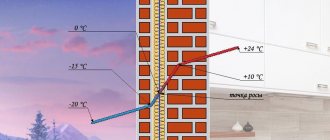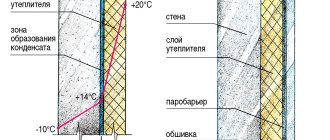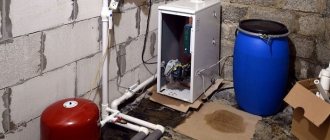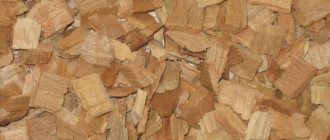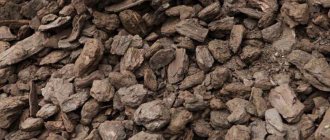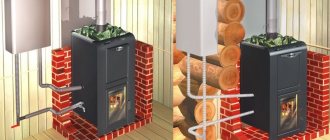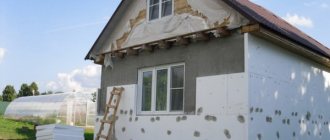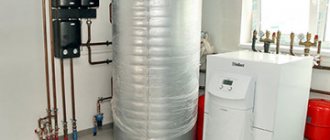Wet grass underfoot, foggy windows, droplets on the walls of a damp basement - all this is the result of condensation of water vapor from the atmospheric air. Everyone has encountered this, but not everyone was interested in how to determine the dew point. Most often, this task has to be solved by architects, builders and designers, and people far from this area are hardly familiar with this concept.
How to determine dew point
The nature of the appearance of dew
Water condensation on various surfaces occurs as follows. Atmospheric air is always saturated with water vapor to one degree or another. Water changes from a gaseous state to a liquid state when its temperature decreases. This occurs when atmospheric air comes into contact with colder surfaces and subsequent heat loss. The result is the appearance of water droplets.
Morning dew is easily explained by the laws of physics
The temperature at which water vapor from the air passes into a liquid state is called dew point .
The higher the content of water vapor in the air (or other mixture of gases), the higher the condensation temperature of water, or dew point. So, with a relative air humidity of 100%, the dew point exactly coincides with its temperature. And vice versa: the lower the relative air humidity, the lower the dew point. This means that for condensation to fall out, you will have to cool the air more.
Studying the dew point in construction
Comfortable dew point values for humans
| Dew point, °C | Human perception | Relative humidity (at 32°С), % |
| more than 26 | extremely high perception, deadly for asthma patients | 65 and above |
| 24-26 | extremely uncomfortable condition | 62 |
| 21-23 | very humid and uncomfortable | 52-60 |
| 18-20 | unpleasant for most people | 44-52 |
| 16-17 | comfortable for most, but feels at the upper limit of humidity | 37-46 |
| 13-15 | comfortable | 38-41 |
| 10-12 | very comfortable | 31-37 |
| less than 10 | a little dry for some | 30 |
Scope of the concept
This term is widely used in industrial and civil construction. The need to determine this value arises when insulating the walls of a room. If you neglect to calculate this indicator, problems will appear after insulation work. One option is damage to the wall finish due to settling moisture. If the finish is tolerant of water, but drops of condensation will fall on the walls, there is nothing good about it either. A humid environment promotes the development of pathogenic microorganisms and mold.
In aviation, dew point is also calculated. During the flight, condensation occurs on some parts of the aircraft. In this case, the condensate freezes and parts of the aircraft become icy.
Ignoring the dew point can lead to a plane crash.
This value is also used in forestry. Forest fire protection specialists use the dew point to calculate the fire hazard class, which characterizes the possibility of forest fires. Based on this, protective measures are designed.
Dew point is used in calculations for planning fire prevention measures
In agriculture, knowing the dew point, the probability of damage to crops by non-infectious diseases (damage caused by weather conditions) is determined. At the same time, one of the tasks of breeding is to develop varieties of cultivated plants capable of condensing moisture from the air on their vegetative organs. This will allow successful farming in conditions of low rainfall.
Dew point placement
Ways to eliminate condensation on entrance doors
The way to get rid of condensation is to ensure the influx of dry fresh air from outside and the outflow of vapors from the enclosed space. It is possible to install a “warm curtain”, which will heat the door with heated air. The surface temperature of the door leaf will increase and the dew point will shift. Insulating the door leaf will not eradicate condensation problems. Condensing moisture settles due to the large temperature difference between the outside and the room. In this case, it is recommended to install an unheated vestibule at the entrance. It would not be amiss to equip a canopy over the entrance to protect the door from direct exposure to the sun's rays and precipitation. It is recommended to open the metal sheet of the front door with special powder polymers. It is better to fill all hollow elements in a metal door with foam in order to eliminate the appearance of cold bridges.
How to calculate dew point
According to the mathematical formula
Carrying out calculations manually using a formula is a fairly accurate method. However, to use the formula, you must first determine several other indicators. The formula looks like this:
Formula for calculating dew point
As can be seen from the figure, a and b are constant quantities. T – air temperature. Rh – relative air humidity. This calculation method will give results with an error of 0.5ºС.
Using an online calculator
Since manual calculation using a formula is not suitable for everyone (due to insufficient knowledge in mathematics or lack of time), online calculators are publicly available on the Internet that calculate the dew point based on the entered information. Using them is absolutely simple: you just need to enter the initial data (ambient air temperature and relative humidity). The result of the calculations will appear on the screen.
Calculator programs
Not everyone can relate the dew point indicator and the expected consequences of improper insulation. This requires specific knowledge in physics and construction. Therefore, in addition to conventional calculators that calculate this value, programs with advanced capabilities have been created. They are also freely available and can be used online.
Such programs take into account many parameters when calculating:
- The locality in which the building was built (is under construction). Statistics of average monthly temperatures, relative humidity, and pressure in this region immediately appear.
- Type of room. Obviously, the air humidity in the bathroom will be higher than in the room, and this in turn affects the type of permissible insulation.
- Construction type. Here you can choose from a wall, ceiling, attic floor and other positions.
- Layers of construction. Here it is taken into account what is located behind the insulated wall - another room or street.
- Floor or wall material.
- Temperature and relative humidity of indoor and outdoor air.
After filling in all the required fields, the program will create a dew point graph.
Dew point determination table
If you need to quickly obtain the dew point value, tables are used. The table data is very inaccurate and gives approximate results. But they are easy and quick to use: you just need to find the desired cell at the intersection of the column and row with the desired temperature and relative humidity.
Table 1. Determination of dew point by two indicators.
Determination of dew point by two indicators
Special tools
In meteorology, special tools have been invented to determine the dew point. However, even to calculate using a mathematical formula or any other method described above, you need your own tools.
Temperature is measured with a thermometer, humidity with a hygrometer. For convenience, in this case, a tool capable of measuring both temperature and air humidity is suitable - a digital thermohygrometer.
This instrument combines the functions of a thermometer and a hygrometer.
In addition, there are devices that combine several functions: measuring temperature, humidity, calculating dew point and storing information.
In most cases, working with such a device looks like this.
- Turn on the device. Pay attention to the battery charge.
This is what one of the popular devices looks like - Place the tip of the sensor at a right angle to the surface under study.
The correct position of the device will ensure accurate measurements - To hold the measurement data, press the Hold button in the menu. This way you can view the results in a comfortable position of the device.
Recording does not mean saving - To save the data, click the Save button.
The ability to save eliminates the need to write data in a notepad - If you need to transfer information to a computer, connect the device to the network via USB.
Connecting a dew point meter to a computer is no more difficult than a mobile phone - Copy the data to your computer.
Computer – reliable data storage
Working with devices for measuring dew point is simple even for a person without special training. The interface is intuitive, and if you have any questions, please refer to the instructions.
Consequences of incorrect calculations
When choosing materials for insulation, remember that one of the effective ways to protect external walls from moisture is to correctly arrange the layers of insulation.
High-quality thermal insulation will help to significantly reduce heat loss and maintain comfort in the house, as well as extend the life of the walls
A dense layer that will not allow steam to pass through should be placed on the inside of the load-bearing wall, and a porous layer that allows moisture to pass through should be placed on the outside.
It is also necessary to create conditions for ventilation at the condensation point. In this case, the condensate will evaporate without obstacles.
A properly insulated external wall will help reduce heat loss during the heating season from 45 to 95% and create comfort in the house
If the insulation was chosen incorrectly, then moisture will accumulate in it gradually and the thermal resistance number of the wall will decrease. Therefore, in the second, or maximum in the fifth, heating season, heating costs will increase, if this is a private house, the apartment will simply be much colder in winter.
Professional insulation is a long and expensive process. Today there are many materials for insulation. Do not try to save on them, as cheap materials will become unusable after a few heating seasons and begin to deteriorate.
There are several consequences of incorrect calculations, but some of them can negatively affect the quality of life. The main consequence will be constantly wet walls, as a result of fungus, mold, microbes on the walls, which entails the appearance of many chronic diseases.
Constantly wet walls become a breeding ground for the growth of fungus and mold, because their spores fly in the air and can cause illness
Since a damp room is difficult to heat, the comfort level drops. And high humidity inside such walls can cause respiratory diseases.
Another unpleasant consequence of incorrect calculations is the destruction of finishing materials - tiles crumble, bricks on the external wall crumble, and inside the room the surface on the walls will begin to swell.
Undried condensation is the key reason for swelling and delamination of finishing materials on the external wall
To correct the situation, you should contact specialists to analyze the condition of the walls and insulation. With the correct calculations, you can correct all mistakes and create comfortable and warm conditions in your home.
The following article will introduce you to the rules and formulas for conducting thermal engineering calculations for competent house design, which we highly recommend reading.
The importance of determining dew point
If you do not take into account the position of the dew point in the wall, a series of negative events will follow.
The insulation material quickly becomes unusable, and the service life of the wall material itself is reduced. Due to regular wetting, the finish will not hold up: the wallpaper gradually peels off, the plaster crumbles, and the paint peels off. Due to excess humidity in the room, mold, mildew and other pathogenic microorganisms develop in a short period of time on walls, ventilation systems, ceilings and other surfaces.
Ignoring the physical nature of condensation can lead to unsanitary conditions in the room
Causes of window fogging and how to fix them
Single-chamber double-glazed windows - you should not save on double-glazed windows, as they say, the miser pays twice. An ordinary double-glazed window with one chamber (not energy-saving) will certainly allow you to get acquainted with condensation on the windows. To eliminate the cause of fogging, it is necessary to replace the double-glazed window, not the entire window, but only the double-glazed window.
The window sill covers the radiator
Wrong
Right
Heating radiators blow warm air onto the window, and if they are blocked by the window sill, then there will be no circulation of warm air - the window will always be cold, and as a result, condensation will appear on it.
You can get rid of condensation by reducing the size of the window sill or moving the battery outside the window sill board. If such options are not possible, you will have to look for an additional source for heating the glass.
Poor ventilation
Ventilation grilles often tend to become clogged with all sorts of rubbish - dust, cobwebs, after which they stop drawing in moist air, moisture settles on the glass and the windows begin to cry. And in old houses, the ventilation ducts are almost always clogged and have never been cleaned.
Read about free ventilation with clean air in the article about geothermal ventilation of a country house
An example of organizing air flow: ventilation and air ionization
You can eliminate the formation of condensation by cleaning or replacing the grilles, and if the ventilation is clogged and there is no way to clean it, you will have to do additional ventilation.
How does dew behave on uninsulated walls?
With uninsulated walls, there are several variations in the behavior of the dew point. In some situations, it is located in the inner space of the wall - closer to the street or closer to the room. In the second case, with a strong decrease in temperature, the place of steam condensation will shift to the inner surface of the wall. Then drops of condensation will certainly form on its surface.
Uninsulated walls often get wet
In some cases (cold building frame material), the dew point can be located indoors all year round, that is, on the inner surface of the wall. Then it is necessary to make applied calculations and take care of the insulation of the wall, taking into account the climatic characteristics of the locality in which the building is located.
In general, the location of the dew point in a ceiling or wall is interconnected with a number of physical factors:
- humidity of outdoor air and indoor air;
- outdoor and indoor air temperatures;
- thickness of the ceiling or wall.
IVG-1. Why do you need a device to measure the dew point of gas?
Determining low moisture concentrations in dew point units in process gases is a common task in many industries. The moisture content during production, transportation and storage of various types of products is regulated by the standards of each industry. These rules define the conditions of technological processes, which in some cases are very stringent. Current standards place high demands on the control equipment used, so it is important to choose the right hygrometer that will reliably and accurately measure the moisture content of the gas. For many years, it has been producing and supplying specialized dew point meters (hygrometers) of the IVG-1 series for monitoring moisture in air and non-aggressive process gas environments. In the article we will look at what gas dew point is, why it is important to measure it, and what characteristics IVG-1 hygrometers have for measuring it in various industries.
Dew point in externally insulated walls
With the correct selection of material and correctly calculated thickness of the insulating layer, the dew point will always be in the insulation and will never move towards the inner surface. The walls are dry all year round. Only the insulation is damaged by weather conditions; the wear of the walls slows down.
External insulation is the surest protection against condensation in the apartment
If the thickness of the insulation is less than required, or the thermal conductivity of the material has not been taken into account, the dew point will behave in the same way as in an uninsulated wall, that is, moisture will continue to accumulate in the room if it accumulated before insulation. If this happens, there is only one way out - to increase the thickness of the insulating material. This can be done by adding another layer of thermal insulation or replacing the old material with a new one of suitable thickness.
If the insulating layer is excessively thick, the dew point will not go beyond its limits throughout the year. This will not entail any negative consequences: the wall will be dry all year round. However, calculations are made in order to avoid unreasonable financial expenses. After all, if you can escape moisture and retain heat with less insulation, then why spend more?
Should I insulate the walls inside or outside?
Where to buy quality dew point meters
Our company supplies equipment for monitoring dew point temperature. Experienced experts are ready to help you select the product that best suits your needs. Write or call right now - and within a day the order will be delivered to you, if this is physically feasible. Dew point devices are available in stock in St. Petersburg. Delivery to populated areas of the Russian Federation and the countries of the Commonwealth of Independent States is carried out by proven cargo carriers.
Industrial air flow meter Borey-450
General industrial analogue pressure sensor TD-10.107
Dew point in internally insulated walls
Insulating walls only from the inside inevitably leads to a shift in the dew point towards the room. This happens because the thermal insulation material retains heat in the room, thereby making the wall colder. And, as you know, the colder the surface, the more likely it is that air moisture will condense on it.
If at normal temperatures for a given region the dew point is located close to the inner surface of the wall and does not cause any inconvenience, then on particularly cold days it can move into the room, that is, onto the inner surface of the wall. Then the wall will get wet under the insulation.
If moisture constantly accumulates on an uninsulated wall, then after work on the internal insulation of the room, the wall will continue to get wet under the insulation throughout the cold season. This will lead to gradual deterioration of all layers of building materials located on the inside of the wall, including the finishing.
Internal insulation does not protect against getting wet
In some cases, after internal insulation of a normal wall, the dew point changes location to the insulation. Then, throughout the winter, not only the wall will be wet, but also the thermal insulation material itself.
One way or another, in order to avoid damage to the finish and internal insulation layers, you need to remember one simple rule: insulation of the inner surface of the wall is carried out only after its external insulation.
Definition
The planet's atmosphere constantly contains water vapor in certain quantities. It defines the concept of air humidity. Too dry or too humid air has a negative impact not only on people, animals, plants, but also, for example, on building materials. Therefore, scientists carefully study the nature of this process, as well as the physical phenomena arising in connection with this.
The dew point is a certain cooling temperature of the air space at which water vapor formations, which are inevitably present in the air, change their state, forming condensate in the form of wet drops. This is influenced by two mandatory indicators:
- temperature regime;
- humidity of the air mass, but not absolute, but relative.
As humidity increases, the dew point increases, approaching the temperature. If the relative humidity is one hundred percent, these values are absolutely equalized. But this is only possible theoretically or in laboratory conditions. Already when the dew point in the surrounding space approaches 20 degrees, people feel discomfort: it becomes stuffy, breathing becomes difficult. At 25 degrees, respiratory diseases and cardiovascular pathologies worsen. This dew point indicator is very rare, mainly in tropical latitudes.
About the dew point in plastic windows
When it comes to the dew point in double-glazed windows, many people imagine some specific mysterious place. In reality, the dew point cannot be seen, as we have already found out. Let us repeat: dew point refers to the temperature at which, when cooled, the vapor in the air becomes saturated and condenses. There are special tables that allow you to calculate the dew point at relative humidity and a specific temperature. One such table is shown below.
Dew point at relative humidity
On a note! Let’s say the air humidity is 50% and the temperature is +21 degrees. Under such circumstances, the dew point will be +10.2. What does it mean? If the temperature of any surface in the apartment drops to +10.2 degrees, then condensation will begin to appear on it (the surface). As a rule, the coldest surfaces in the apartment are plastic windows, and therefore it is on them that in most cases excess moisture falls.
People often experience condensation on double-glazed windows. Based on everything said above, we can conclude that condensation can be dealt with in two ways - by increasing the temperature of the glass and reducing the humidity in the apartment. Thus, comfortable humidity can be achieved by ensuring normal air exchange. All excess moisture comes from washing, boiling pots, etc. – should leave the room and not accumulate in it. First of all, the apartment should be regularly ventilated. The frequency of ventilation is determined individually, but we recommend doing this for at least 10 minutes twice a day. Don’t forget about special supply ventilation valves.
Condensation on windows
Very often, manufacturers of modern windows have to accept complaints that their customers' windows are fogging up. The formation of condensation on windows is not only aesthetically unsightly, but also threatens the wooden structures with waterlogging and, as a result, the formation of mold. Let's look at the possible causes of condensation on windows.
Condensation is a liquid that has passed the dew point and fallen in the form of droplets on the window.
Well, if this happened on windows, then only the windows and their manufacturers are to blame. Logically this is correct, but if there is no water in the window itself and it cannot release it, where does the condensation come from?

